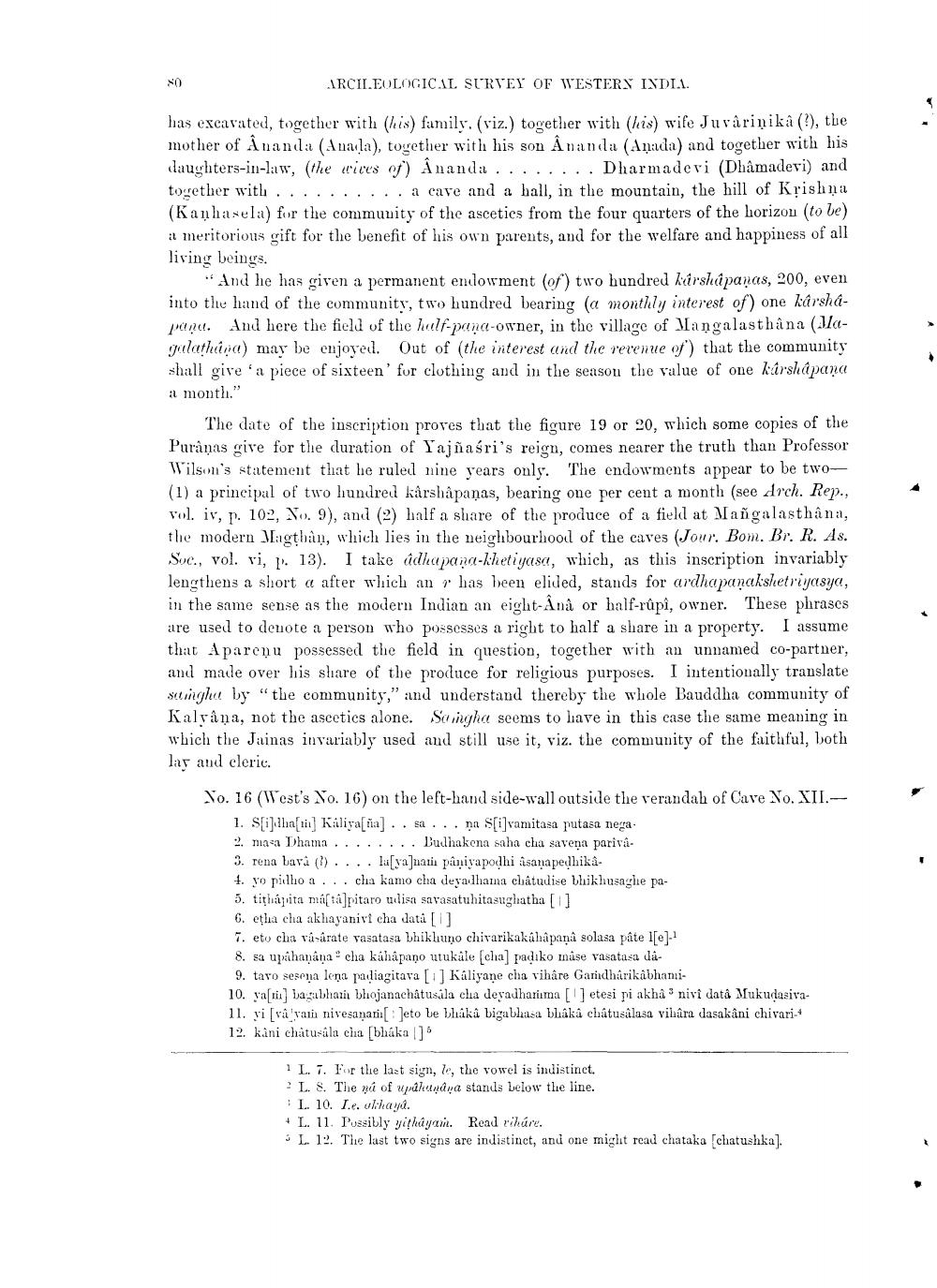________________
NO
IRCHEOLOGICIL SURVEY OF WESTERX IXDI.1.
has excavated, together with (his) family. (viz.) together with (his) wife Jurâriņika (?), the mother of Ananda (Anala), together with his son Avanda (Anada) and together with his daughters-in-law, (the wives of) Ânanda . . . . . . . . Dharmaderi (Dhậmadevi) and together with .......... a cave and a hall, in the mountain, the hill of Krishna (Kanhanela) for the community of the asceties from the four quarters of the horizou (to be) al meritorious gift for the benefit of his own parents, and for the welfare and happiness of all living beings.
"And he has given a permanent endowment (of) two hundred kúrshápanas, 200, even into the hand of the community, two hundred bearing (a monthly interest of one kárshápanu. And here the field of the hulf-pana-owner, in the village of Mangalasthana (Magulathina) may be enjoyed. Out of the interest and the revenue of) that the community shall give 'a piece of sixteen' for clothing and in the season the value of one kärshapana a month."
The date of the inscription proves that the figure 19 or 20, which some copies of the Puranas give for the duration of Yajñasri's reign, comes nearer the truth than Professor Wilson's statement that he ruled nine years only. The endowments appear to be two(1) a principal of two hundred kårshậpaņas, bearing one per cent a month (see Arch. Rep., vol. iv, p. 102, No. 9), and (2) half a share of the produce of a field at Mañgalasthana, the modern Jagthan, which lies in the neighbourhood of the caves (Jour. Bom. Br. R. As. Soc., vol. vi, . 13). I take adhapana-khetiyasa, which, as this inscription invariably lengthens a short a after which an has been elided, stands for ardhapanakshetriyasya, in the same sense as the modern Indian an eight-Ânå or half-růpi, owner. These phrases are used to deuote a person who possesses a right to half a share in a property. I assume that Apareņu possessed the field in question, together with an unnamed co-partner, and made over his share of the produce for religious purposes. I intentionally translate sanghu by “the community," and understand thereby the whole Bauddha community of Kalvána, not the ascetics alone. Saingha seems to have in this case the same meaning in which the Jainas invariably used and still use it, viz. the community of the faithful, both las and cleric.
No. 16 (West's No. 16) on the left-hand side-wall outside the verandah of Cave No. XII.
1. S[i]hati] Kiliya[na] .. sa ... nn S[i]vamitasa putasa nega 2. masa Dhama ........ Budhakena saha cha savena pariva. 3. rena lava ().... lu[valnati pânivapodhi Asanapedhika 4. yo piilho a ... cha kamo cha deyadhama châtudie bhikhusache pa5. tithájiita matapitaro ulisa savasatuhitasughatha [1] 6. etha cha akhayanivi cha data [1] 7. eto cha vásárate vasatasa bhikliuno chivarikakahapana solasa pâte 1[0]. 8. sa upahanana cha kahapano utukäle chal padiko mase vasatasa de 9. tavo sesona lona padliagitava [1] Käliyane cha vihåre Gardharikábhami 10. ya 11) ianubhari bhojanachâtusala cha deyadhariima [1] etesi ri akhanivi data Mukudasiva11. yi[vậyatinivesanari: Jeto be bhikû bigablusa bláká châtusalasa vihara dasakani chivari 12. kani chatusula cha [blákal]
1 L. 7. For the last sign, le, the vowel is indistinct. ? L. S. The nú of upalunûna stands below the line.
L. 10. I.e. ul hayd. + L. 11. Possibly yithiyam. Read rikúre.
L 1. The last two signs are indistinct, and one might read chataka chatushka).




